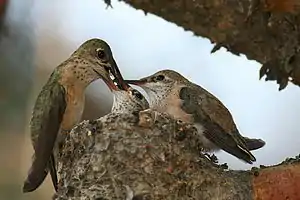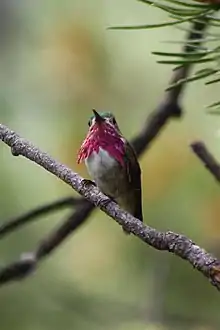Sternelfe
Die Sternelfe (Selasphorus calliope) ist eine Vogelart aus der Familie der Kolibris (Trochilidae). Sie brütet im Sommer in Kanada in British Columbia, und den nordwestlichen Vereinigten Staaten, in Washington, Oregon, Idaho, dem westlichen Montana, West-Utah und Nord- und Ostkalifornien. Zur Überwinterung zieht der Vogel nach Mexiko.[1]
| Sternelfe | ||||||||||
|---|---|---|---|---|---|---|---|---|---|---|

Sternelfe (Selasphorus calliope), Weibchen am Nest | ||||||||||
| Systematik | ||||||||||
| ||||||||||
| Wissenschaftlicher Name | ||||||||||
| Selasphorus calliope | ||||||||||
| (Gould, 1847) |
Aussehen
Der Vogel wiegt 2 bis 3 Gramm, wird rund 9 Zentimeter lang und hat eine Flügelspannweite von 11 Zentimetern.[2] Die Kolibriart ist die kleinste bekannte Vogelart in Nordamerika. Die Männchen erkennt man an der roten Kehle, den grünen Flanken, dem weißen Bauch und dem dunklen Schwanz. Bei den Weibchen ist der Schwanz rotbraun und es fehlt die farbige Kehle. Der Schwanz des Vogels ist auffallend kurz.
Nahrung
Die Nahrung des Kolibris besteht hauptsächlich aus Blütennektar, Pollen und Insekten.
Fortpflanzung

Nach der Balz und der Begattung wird in einem Baum meist versteckt ein Nest angelegt. Das Weibchen legt gewöhnlich zwei Eier, die zwischen 14 und 16 Tagen bebrütet werden. Nach dem Schlüpfen werden die Jungen rund 21 bis 28 Tage gefüttert.
Feinde
Die natürlichen Feinde des Kolibris sind Schlangen, Katzen und Greifvögel.
Unterarten

Bisher sind keine Unterarten bekannt.[3] Die Unterart Selasphorus calliope lowei (Griscom, 1934)[4], die man gelegentlich in der Literatur findet gilt als Junior Synonym zur Nominatform.
Etymologie und Forschungsgeschichte
John Gould beschrieb die Sternelfe unter dem Namen Trochilus (Calothorax) Calliope. Das Typusexemplar wurde in Mexiko gesammelt.[5] Später schlug sie Gould der neuen Gattung Stellula zu, eine monotypische Gattung, unter der sie sehr lange geführt wurde.[6] Das North American Classification Committee schlug sie schließlich im Jahr 2012 eindeutig der Gattung Selasphorus zu.[7]
Das Wort Selasphorus leitet sich von den lateinischen Worten »selas σέλας« für »Glanz, Licht, Flamme« und »-phoros, pherō πηοροσ« für »tragend, Träger« ab.[8]
Das Wort »calliope« stammt aus der griechischen Mythologie. Kalliope war eine Muse mit feiner Stimme und eine der neun Töchter des Zeus und der Mnemosyne.[9]
Literatur
- Dieter Poley: Kolibris: Trochilidae. Westarp Wissenschaften, Hohenwarsleben 1994, ISBN 978-3-89432-409-4.
- Josef H. Reichholf, Scott Weidensaul: Kolibris. Fliegende Diamanten. Karl Müller Verlag, Köln-Bocklemünd/Mengenich 1990.
- John Gould: Drafts for an arrangement of the Trochilidae, with descriptions of some new species. In: Proceedings of the Zoological Society of London. Band 15, Nr. 168, 1847, S. 7–11 (online [abgerufen am 13. Februar 2014]).
- John Gould: An introduction to the Trochilidæ: or family of humming-birds. Taylor and Francis, London 1861 (online [abgerufen am 13. Februar 2014]).
- James A. Jobling: Helm Dictionary of Scientific Bird Names. Christopher Helm, London 2010, ISBN 978-1-4081-2501-4.
- Ludlow Griscom: The Ornithology of Guerrero, Mexico. In: Bulletin of the Museum of Comparative Zoology at Harvard College. Band 75, Nr. 10, 1934, S. 367–422 (online [abgerufen am 17. Januar 2012]).
Einzelnachweise
- National Geographic Society: Field Guide to the Birds of North America, Second Edition. National Geographic, ISBN 0-87044-692-4
- Cornell Lab of Ornithology
- IOC World Bird List Hummingbirds
- Ludlow Griscom, S. 380
- John Gould (1847), S. 11
- John Gould (1861), S. 90
- North American Classification Committee Proposal 2011-A
- James A. Jobling S. 352
- James A. Jobling S. 85
Weblinks
- Selasphorus calliope in der Roten Liste gefährdeter Arten der IUCN 2011.2. Eingestellt von: BirdLife International, 2009. Abgerufen am 17. Januar 2011.
- Factsheet auf BirdLife International
- Videos, Fotos und Tonaufnahmen zu Calliope Hummingbird (Stellula calliope) in der Internet Bird Collection
- Sternelfe (Selasphorus calliope) bei Avibase; abgerufen am 17. Januar 2011.
- Stellula calliope im Integrated Taxonomic Information System (ITIS). Abgerufen am 17. Januar 2011.
- xeno-canto: Tonaufnahmen – Calliope Hummingbird (Stellula calliope)
- Calliope Hummingbird – Stellula calliope USGS Patuxent Bird Identification InfoCenter (engl.)
- Calliope Hummingbird Information and Photos South Dakota Birds and Birding (engl.)